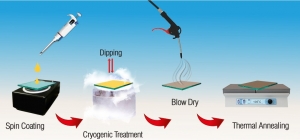A Cryogenic Process for Perovskite Solar Cells without Anti-Solvents

We are pleased to share the results of the work of a team of scientists from Nazarbayev University and Hong Kong Polytechnic University on the use of the cryogenic process for perovskite solar cells without the use of anti-solvents. This project is an ecofriendly technique to produce perovskites by eliminating harmful chemicals.
With an efficiency increase from 3.8% in 2009 to 22.7% at the end of 2017, perovskite solar cells are growing rapidly. Perovskite solar cells are lighter and cheaper than silicon ones, and the cells themselves can be made thin and flexible.
Usually, anti-solvents are used to make thin mixed perovskite films, but this method is inconvenient for large-scale industrial production, since the quality of the final perovskite film is critically dependent on many parameters when the anti-solvent is added. In addition, the anti-solvents used in production are toxic and harmful to the environment.
Scientists from Nazarbayev University and Hong Kong Polytechnic University - Annie Ng, Charles Surya, Zhiwei Ren, Hanlin Hu, Patrick WK Fong, Qian Shen, Sin Hang Cheung, Pingli Qin, Jin-Wook Lee, Aleksandra B. Djurišic´, Shu Kong So, Gang Li and Yang Yang demonstrated a 4-step process including spin-coating of the precursors, cryogenic treatment, blow-dry process for the removal of the solvent, and thermal annealing.

This unique method enhances control over the growth process of perovskite, the time window for film formation can be increased, which allows better control of the growth process, obtaining a homogeneous film.
The proposed strategy has universal application for various mixed perovskites and is easily scalable to larger device areas without the consumption of anti-solvents, which is an important breakthrough towards environmental‐friendly manufacturing.
Another important attribute of the proposed cryo-controlled technique is the ease of scalability by using the cryogenic treatment for large area substrates. In the future, the group will replace the spin coating process with other types of large scale solution processing techniques and use green solvents to further improve the process.



